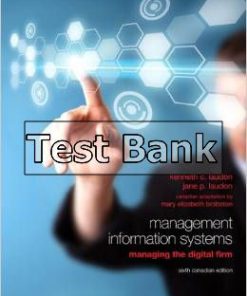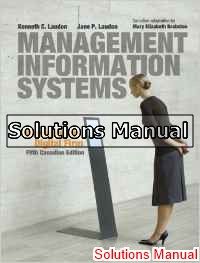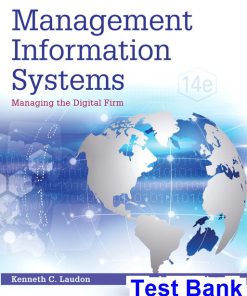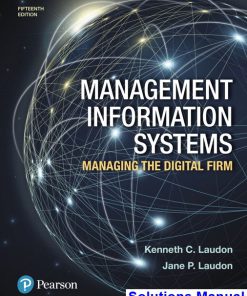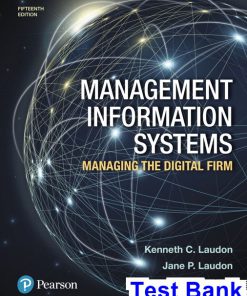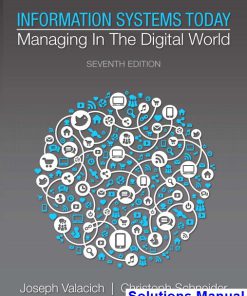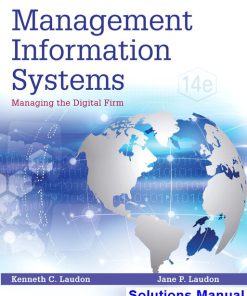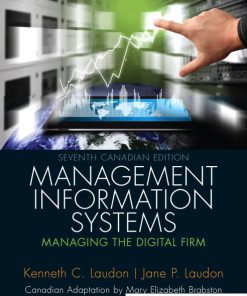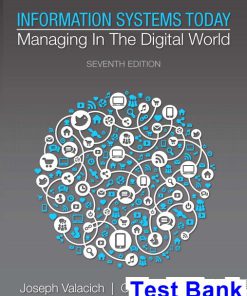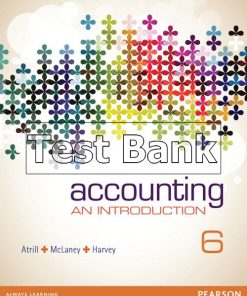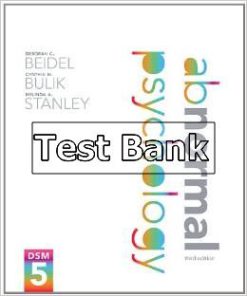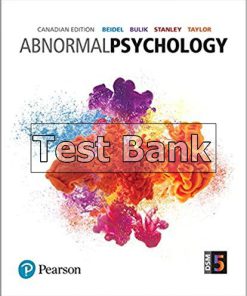Management Information Systems Managing the Digital Firm Canadian 7th Edition Laudon Test Bank
$50.00 Original price was: $50.00.$26.50Current price is: $26.50.
Management Information Systems Managing the Digital Firm Canadian 7th Edition Laudon Test Bank.
Management Information Systems Managing the Digital Firm Canadian 7th Edition Laudon Test Bank
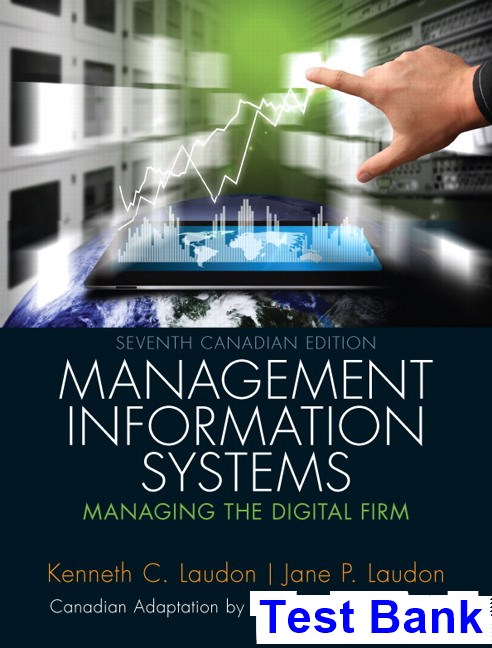
Product details:
- ISBN-10 : 0133156842
- ISBN-13 : 978-0133156843
- Author:
Laudon continues to be authoritative but is also more customizable, flexible, and geared to meeting the needs of different colleges, universities, and individual instructors.
Information systems are one of the major tools available to business managers for achieving operational excellence, developing new products and services, improving decision making, and achieving competitive advantage. Students will find here the most up-to-date and comprehensive overview of information systems used by business firms today.
Table contents:
- Part I Organizations, Management, and the Networked Enterprise
- Chapter 1 Information Systems in Business Today
- Learning Objectives
- 1.1 The Role of Information Systems in Business Today
- How Information Systems are Transforming Business
- What Is New in Management Information Systems?
- Globalization Challenges and Opportunities: A Flattened World
- The Emerging Digital Firm
- Strategic Business Objectives of Information Systems
- Operational Excellence
- New Products, Services, and Business Models
- Customer and Supplier Intimacy
- Improved Decision Making
- Competitive Advantage
- Survival
- 1.2 Perspectives on Information Systems
- What Is an Information System?
- Dimensions of Information Systems
- Organizations
- Management
- Information Technology
- It Is Not Just Technology: A Business Perspective on Information Systems
- Complementary Assets: Organizational Capital and the Right Business Model
- 1.3 Contemporary Approaches to Information Systems
- Technical Approach
- Behavioural Approach
- Approach of This Text: Sociotechnical Systems
- Learning Track Modules
- Review Summary
- Key Terms
- Review Questions
- Discussion Questions
- Hands-On MIS Projects
- Management Decision Problems
- Improving Decision Making: Using Databases to Analyze Sales Trends
- Improving Decision Making: Using the Internet to Locate Jobs Requiring Information Systems Knowledge
- Collaboration and Teamwork Project
- Chapter 2 How Businesses Use Information
- Learning Objectives
- 2.1 Business Processes and Information Systems
- Business Processes
- How Information Technology Improves Business Processes
- 2.2 Types of Information Systems
- Systems for Different Management Groups
- Transaction Processing Systems
- Systems for Business Intelligence
- Systems for Linking the Enterprise
- Enterprise Applications
- Enterprise Systems
- Supply Chain Management Systems
- Customer Relationship Management Systems
- Knowledge Management Systems
- Intranets and Extranets
- E-Business, E-Commerce, and E-Government
- 2.3 Systems for Collaboration and Social Business
- What Is Collaboration?
- What Is Social Business?
- Business Benefits of Collaboration and Social Business
- Building a Collaborative Culture and Business Processes
- Tools and Technologies for Collaboration and Social Business
- E-mail and Instant Messaging (IM)
- Wikis
- Virtual Worlds
- Collaboration and Social Business Platforms
- Virtual Meeting Systems
- Google Apps/Google Sites and Cloud Collaboration Services
- Microsoft SharePoint
- Lotus Notes
- Enterprise Social Networking Tools
- Checklist for Managers: Evaluating and Selecting Collaboration and Social Software Tools
- 2.4 The Information Systems Function in Business
- The Information Systems Department
- Organizing the Information Systems Function
- Learning Track Modules
- Review Summary
- Key Terms
- Review Questions
- Discussion Questions
- Hands-On MIS Projects
- Management Decision Problems
- Improving Decision Making: Using a Spreadsheet to Select Suppliers
- Achieving Operational Excellence: Using Internet Software to Plan Efficient Transportation Routes
- Collaboration and Teamwork Project
- Chapter 3 Information Systems, Organizations, and Strategy
- Learning Objectives
- 3.1 Organizations and Information Systems
- What Is an Organization?
- Features of Organizations
- Routines and Business Processes
- Organizational Politics
- Organizational Culture
- Organizational Environments
- Disruptive Technologies: Riding the Wave
- Organizational Structure
- Other Organizational Features
- 3.2 How Information Systems Impact Organizations and Business Firms
- Economic Impacts
- Organizational and Behavioural Impacts
- IT Flattens Organizations
- Postindustrial Organizations
- Understanding Organizational Resistance to Change
- The Internet and Organizations
- Implications for the Design and Understanding of Information Systems
- 3.3 Using Information Systems to Achieve Competitive Advantage
- Porter’s Competitive Forces Model
- Traditional Competitors
- New Market Entrants
- Substitute Products and Services
- Customers
- Suppliers
- Information System Strategies for Dealing with Competitive Forces
- Low-Cost Leadership
- Product Differentiation
- Focus on Market Niche
- Strengthen Customer and Supplier Intimacy
- The Internet’s Impact on Competitive Advantage
- The Business Value Chain Model
- Extending the Value Chain: The Value Web
- Synergies, Core Competencies, and Network-Based Strategies
- Synergies
- Enhancing Core Competencies
- Network-Based Strategies
- Network Economics
- Virtual Company Model
- Business Ecosystems: Keystone and Niche Firms
- 3.4 Using Systems for Competitive Advantage: Management Issues
- Sustaining Competitive Advantage
- Aligning IT with Business Objectives
- Management Checklist: Performing a Strategic Systems Analysis
- Managing Strategic Transitions
- Learning Track Module
- Review Summary
- Key Terms
- Review Questions
- Discussion Questions
- Hands-On MIS Projects
- Management Decision Problems
- Improving Decision Making: Using a Database to Clarify Business Strategy
- Improving Decision Making: Using Web Tools to Configure and Price an Automobile
- Collaboration and Teamwork Project
- Chapter 4 Social, Ethical, and Legal Issues in the Digital Firm
- Learning Objectives
- 4.1 Understanding Ethical and Social Issues Related to Systems
- A Model for Thinking about Social, Legal, and Ethical Issues
- Five Moral Dimensions of the Information Age
- Key Technology Trends that Raise Ethical Issues
- 4.2 Ethics in an Information Society
- Basic Concepts: Responsibility, Accountability, and Liability
- Ethical Analysis
- Candidate Ethical Principles
- Professional Codes of Conduct
- Some Real-World Ethical Dilemmas
- 4.3 The Moral Dimensions of Information Systems
- Information Rights: Privacy and Freedom in the Internet Age
- The European Directive on Data Protection
- Internet Challenges to Privacy
- Technical Solutions
- Property Rights: Intellectual Property
- Trade Secrets
- Copyright
- Patents
- Challenges to Intellectual Property Rights
- Accountability, Liability, and Control
- Computer-Related Liability Problems
- System Quality: Data Quality and System Errors
- Quality of Life: Equity, Access, and Boundaries
- Balancing Power: Centre Versus Periphery
- Rapidity of Change: Reduced Response Time to Competition
- Maintaining Boundaries: Family, Work, and Leisure
- Dependence and Vulnerability
- Computer Crime and Abuse
- Employment: Trickle-Down Technology and Reengineering Job Loss
- Equity and Access: Increasing Racial and Social Class Cleavages
- Health Risks: RSI, CVS, and Technostress
- Learning Track Module
- Review Summary
- Key Terms
- Review Questions
- Discussion Questions
- Hands-On MIS Projects
- Management Decision Problems
- Achieving Operational Excellence: Creating a Simple Blog
- Improving Decision Making: Using Internet Newsgroups for Online Market Research
- Collaboration and Teamwork Project
- Part II Information Technology Infrastructure
- Chapter 5 IT Infrastructure and Emerging Technologies
- Learning Objectives
- 5.1 IT Infrastructure
- Defining IT Infrastructure
- Evolution of IT Infrastructure
- General-Purpose Mainframe and Minicomputer Era (1959 to Present)
- Personal Computer Era (1981 to Present)
- Client/Server Era (1983 to Present)
- Enterprise Computing Era (1992 to Present)
- Cloud and Mobile Computing Era (2000 to Present)
- Technology Drivers of Infrastructure Evolution
- Moore’s Law and Microprocessing Power
- The Law of Mass Digital Storage
- Metcalfe’s Law and Network Economics
- Declining Communications Costs and the Internet
- Standards and Network Effects
- 5.2 Infrastructure Components
- Computer Hardware Platforms
- Operating System Platforms
- Enterprise Software Applications
- Data Management and Storage
- Networking/Telecommunications Platforms
- Internet Platforms
- Consulting and Systems Integration Services
- 5.3 Contemporary Hardware Platform Trends
- The Mobile Digital Platform
- Consumerization of IT and BYOD
- Grid Computing
- Virtualization
- Cloud Computing
- Green Computing
- High-Performance and Power-Saving Processors
- Autonomic Computing
- 5.4 Contemporary Software Platform Trends
- Linux and Open-Source Software
- Linux
- Software for the Web: Java, HTML, and HTML5
- Web Services and Service-Oriented Architecture
- Software Outsourcing and Cloud Services
- Software Packages and Enterprise Software
- Software Outsourcing
- Cloud-Based Software Services and Tools
- Mashups and Apps
- 5.5 Management Issues
- Dealing with Platform and Infrastructure Change
- Management and Governance
- Making Wise Infrastructure Investments
- Total Cost of Ownership of Technology Assets
- Competitive Forces Model for IT Infrastructure Investment
- Learning Track Modules
- Review Summary
- Key Terms
- Review Questions
- Discussion Questions
- Hands-On MIS Projects
- Management Decision Problems
- Improving Decision Making: Using a Spreadsheet to Evaluate Hardware and Software Options
- Improving Decision Making: Using Web Research to Budget for a Sales Conference
- Collaboration and Teamwork Project
- Chapter 6 Databases and Information Management
- Learning Objectives
- 6.1 Organizing Data in a Traditional File Environment
- File Organization Terms and Concepts
- Problems with the Traditional File Environment
- Data Redundancy and Inconsistency
- Program-Data Dependence
- Lack of Flexibility
- Poor Security
- Lack of Data Sharing and Availability
- 6.2 The Database Approach to Data Management
- Database Management Systems
- How a DBMS Solves the Problems of the Traditional File Environment
- Relational DBMS
- Operations of a Relational DBMS
- Non-Relational Databases and Databases in the Cloud
- Capabilities of Database Management Systems
- Querying and Reporting
- Designing Databases
- Normalization and Entity-Relationship Diagrams
- 6.3 Using Databases to Improve Business Performance and Decision Making
- The Challenge of Big Data
- Business Intelligence Infrastructure
- Data Warehouses and Data Marts
- Hadoop
- In-Memory Computing
- Analytic Platforms
- Analytical Tools: Relationships, Patterns, Trends
- Online Analytical Processing (OLAP)
- Data Mining
- Text Mining and Web Mining
- Databases and the Web
- 6.4 Managing Data Resources
- Establishing an Information Policy
- Ensuring Data Quality
- Learning Track Modules
- Review Summary
- Key Terms
- Review Questions
- Discussion Questions
- Hands-On MIS Projects
- Management Decision Problems
- Achieving Operational Excellence: Building a Relational Database for Inventory Management
- Improving Decision Making: Searching Online Databases for Overseas Business Resources
- Collaboration and Teamwork Project
- Chapter 7 Telecommunications, the Internet, and Wireless Technology
- Learning Objectives
- 7.1 Telecommunications and Networking in Today’s Business World
- Networking and Communication Trends
- What is a Computer Network?
- Networks in Large Companies
- Key Digital Networking Technologies
- Client/Server Computing
- Packet Switching
- TCP/IP and Connectivity
- 7.2 Communications Networks
- Signals: Digital vs. Analog
- Types of Networks
- Local Area Networks
- Metropolitan and Wide Area Networks
- Transmission Media and Transmission Speed
- Bandwidth: Transmission Speed
- 7.3 The Global Internet
- What is the Internet?
- Internet Services and Communication Tools
- Internet Services
- Voice over IP
- Unified Communications
- Virtual Private Networks
- The Web
- Hypertext
- Web Servers
- Searching for Information on the Web
- Search Engines
- Mobile Search
- Search Engine Marketing
- Social Search
- Semantic Search
- Intelligent Agent Shopping Bots
- Web 2.0
- Web 3.0: The Future Web
- 7.4 The Wireless Revolution
- Cellular Systems
- Wireless Computer Networks and Internet Access
- Bluetooth
- Wi-Fi and Wireless Internet Access
- WiMax
- RFID and Wireless Sensor Networks
- Radio Frequency Identification (RFID)
- Wireless Sensor Networks
- Learning Track Modules
- Review Summary
- Key Terms
- Review Questions
- Discussion Questions
- Hands-On MIS Projects
- Management Decision Problems
- Improving Decision Making: Using Spreadsheet Software to Evaluate Wireless Services
- Achieving Operational Excellence: Using Web Search Engines for Business Research
- Collaboration and Teamwork Project
- Chapter 8 Securing Information Systems
- Learning Objectives
- 8.1 System Vulnerability and Abuse
- Why Systems Are Vulnerable
- Internet Vulnerabilities
- Wireless Security Challenges
- Malicious Software: Viruses, Worms, Trojan Horses, and Spyware
- Hackers and Computer Crime
- Spoofing and Sniffing
- Denial-of-Service Attacks
- Computer Crime
- Identity Theft
- Click Fraud
- Global Threats: Cyberterrorism and Cyberwarfare
- Internal Threats: Employees
- Software Vulnerability
- 8.2 Business Value of Security and Control
- Legal and Regulatory Requirements for Electronic Records Management
- Electronic Evidence and Computer Forensics
- 8.3 Establishing a Framework for Security and Control
- Information Systems Controls
- Risk Assessment
- Security Policy
- Disaster Recovery Planning and Business Continuity Planning
- The Role of Auditing
- 8.4 Technologies and Tools for Protecting Information Resources
- Identity Management and Authentication
- Firewalls, Intrusion Detection Systems, and Antivirus Software
- Firewalls
- Intrusion Detection Systems
- Antivirus and Antispyware Software
- Unified Threat Management Systems
- Securing Wireless Networks
- Encryption and Public Key Infrastructure
- Ensuring System Availability
- Controlling Network Traffic: Deep Packet Inspection
- Security Outsourcing
- Security Issues for Cloud Computing and the Mobile Digital Platform
- Security in the Cloud
- Securing Mobile Platforms
- Ensuring Software Quality
- Learning Track Modules
- Review Summary
- Key Terms
- Review Questions
- Discussion Questions
- Hands-On MIS Projects
- Management Decision Problems
- Improving Decision Making: Using Spreadsheet Software to Perform a Security Risk Assessment
- Improving Decision Making: Evaluating Security Outsourcing Services
- Collaboration and Teamwork Project
- Part III Key Applications for the Digital Age
- Chapter 9 Enterprise Applications to Manage Supply Chains and Respond to Customers
- Learning Objectives
- 9.1 Enterprise Systems
- What Are Enterprise Systems?
- Enterprise Software
- Business Value of Enterprise Systems
- 9.2 Supply Chain Management Systems
- The Supply Chain
- Information Systems and Supply Chain Management
- Supply Chain Management Software
- Global Supply Chains and the Internet
- Global Supply Chain Issues
- Demand-Driven Supply Chains: From Push to Pull Manufacturing and Efficient Customer Response
- Business Value of Supply Chain Management Systems
- 9.3 Customer Relationship Management Systems
- What Is Customer Relationship Management?
- Customer Relationship Management Software
- Sales Force Automation (SFA)
- Customer Service
- Marketing
- Operational and Analytical CRM
- Business Value of Customer Relationship Management Systems
- 9.4 Enterprise Applications: New Opportunities and Challenges
- Enterprise Application Challenges
- Next-Generation Enterprise Applications
- Social CRM and Business Intelligence
- Business Intelligence in Enterprise Applications
- Learning Track Modules
- Review Summary
- Key Terms
- Review Questions
- Discussion Questions
- Hands-On MIS Projects
- Management Decision Problems
- Improving Decision Making: Using Database Software to Manage Customer Service Requests
- Achieving Operational Excellence: Evaluating Supply Chain Management Services
- Collaboration and Teamwork Project
People also search:
management information systems 7th edition
information systems management – c724
journal of information systems and technology management
jm information systems
management information systems 4th edition
Instant download after Payment is complete
You may also like…
Test Bank
Management Information Systems Managing the Digital Firm Canadian 6th Edition Laudon Test Bank
Solutions Manual
Management
Management Information Systems Managing the Digital Firm 15th Edition Laudon Solutions Manual
Information Technology
Information Systems Today Managing in the Digital World 7th Edition Valacich Solutions Manual
Management
Management Information Systems Managing the Digital Firm 14th Edition Laudon Solutions Manual
Information Technology
Information Systems Today Managing in the Digital World 7th Edition Valacich Test Bank




